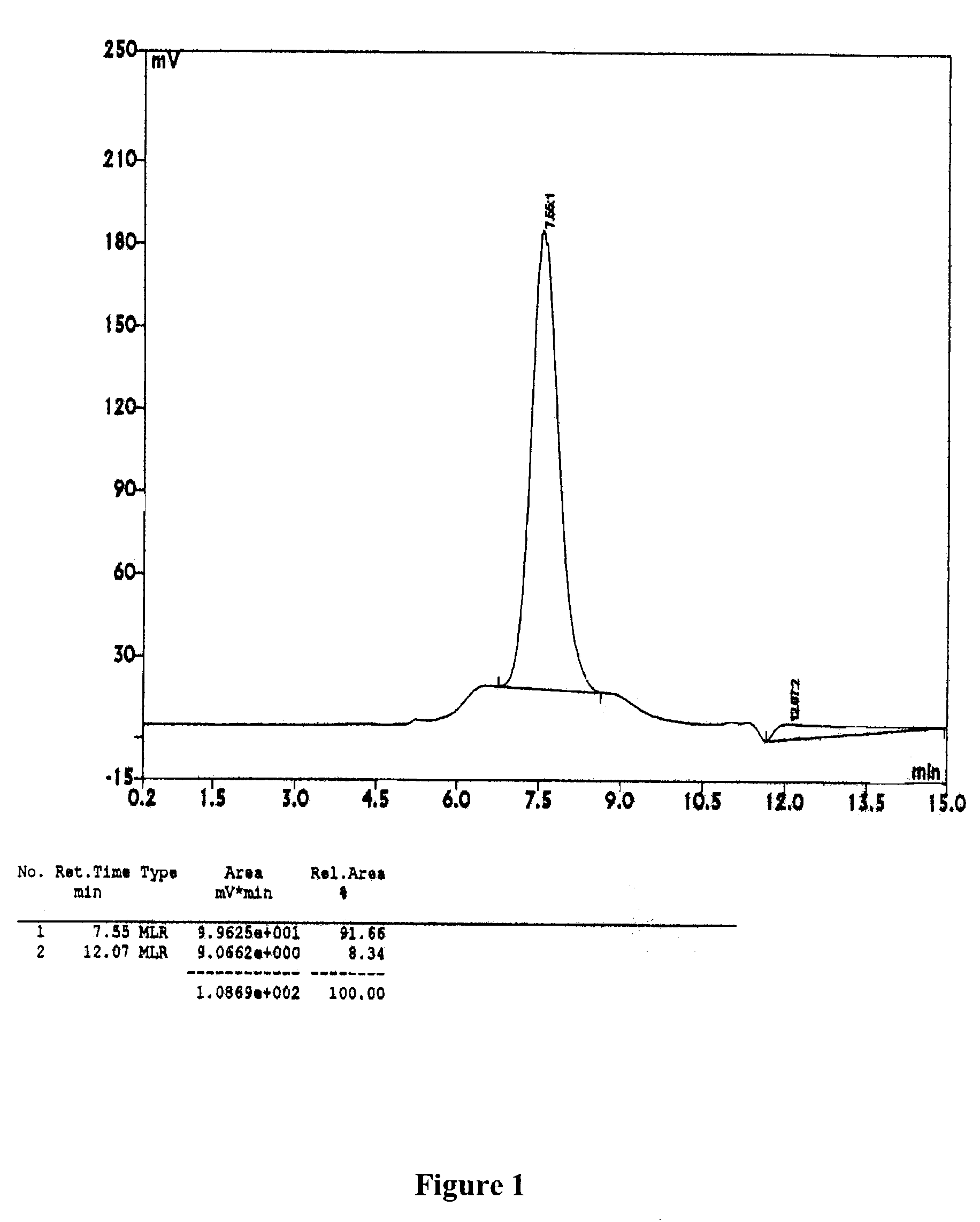Use of intramolecularly, covalently cross-linked proteins as binding partners in immunoassays
a covalently crosslinked, intramolecular technology, applied in the direction of instruments, transferases, peptides, etc., can solve the problems of unstable and denatured materials required for immunological tests, risk, and separation of proteins used as specific binding pairs under unfavourable conditions
- Summary
- Abstract
- Description
- Claims
- Application Information
AI Technical Summary
Benefits of technology
Problems solved by technology
Method used
Image
Examples
example 1
Intramolecular Cross-linking of HIV-1 Reverse Transcriptase
a) Cross-linking with MHS
[0053]HIV-1 reverse transcriptase (10 mg / ml) was dissolved in 50 mM diethanolamine, pH 8.8, 25 mM NaCl, 1 mM DTT, and 1 mM EDTA. The pH was adjusted to 6.4 by adding a 1 M KH2PO4 solution.
[0054]The mixture was adjusted to 5 mM NMM by adding an appropriate aliquot of a 1 M solution of NMM (N-methylmaleinimide) in DMSO and subsequently incubated for 60 min at 25° C. while stirring. It was subsequently dialysed against 50 mM diethanolamine, pH 8.8, 25 mMNaCl.
[0055]The pH was then adjusted to pH 7.0 by adding a 1 M KH2PO4 solution. A stock solution of MHS (3-maleimidobenzoyl-N-hydroxysuccinimide ester) was prepared in DMSO (5 mg / ml). A quantity of this solution corresponding to an initial stoichiometry of 1:8 (mol reverse transcriptase / mol MHS) was added to the mixture which was then incubated for a further 60 min at 25° C. while stirring. The reaction was terminated by adding lysine to the reaction mixt...
example 2
Detection of the Exclusive Intramolecular Cross-linking of HIV-1 Reverse Transcriptase
a) SDS Gel Electrophoresis
[0071]Aliquots of the intramolecularly cross-linked HIV-1 reverse transcriptase were analysed by polyacrylamide gel electrophoresis in the presence of SDS on a PHAST gel apparatus (Pharmacia) according to a standard protocol of the manufacturer.
[0072]The non-cross-linked control only has bands with molecular weights of 66 kD and 51 kD which correspond to the subunits of the reverse transcriptase. Intramolecularly cross-linked reverse transcriptase exhibits bands with molecular weights of 110-120 kD, which demonstrates a successful cross-linking between subunits. Larger protein complexes are not detectable, i.e., an intramolecular linkage of several molecules of reverse transcriptase does not occur with the cross-linking method according to the invention.
b) Analytical Gel Permeation Chromatography
[0073]An aliquot of the intramolecularly cross-linked HIV-1 reverse transcript...
example 3
Derivatization of Intramolecularly Cross-linked HIV-1 Reverse Transcriptase with a Biotin Label
[0075]Intramolecularly cross-linked HIV-1 reverse transcriptase (see example 1) was present in diethanolamine or potassium phosphate buffer. The uncrosslinked RT was treated as a comparison with N-methylmaleimide and dialysed against diethanolamine. If necessary, the pH was adjusted to 8.6-8.8 in all RT mixtures by adding NaOH. A stock of biotin-DDS (biotinyl-diaminodioxaoctane-disuccinimidyl suberate) was prepared in DMSO (6 mg / ml). A quantity of this solution corresponding to an initial stoichiometry of 1:4 (mol reverse transcriptase / mol biotin-DDS) was added to the mixture, which was then incubated for a further 60 min at 25° C. while stirring. The reaction was terminated by adding lysine to the reaction mixture to a final concentration of 10 mM and incubating for a further 30 min. Excess reactants were separated by dialysis against 50 mM diethanolamine, pH 8.8, 25 mM NaCl.
PUM
| Property | Measurement | Unit |
|---|---|---|
| pH | aaaaa | aaaaa |
| pH | aaaaa | aaaaa |
| pH | aaaaa | aaaaa |
Abstract
Description
Claims
Application Information
 Login to View More
Login to View More - R&D
- Intellectual Property
- Life Sciences
- Materials
- Tech Scout
- Unparalleled Data Quality
- Higher Quality Content
- 60% Fewer Hallucinations
Browse by: Latest US Patents, China's latest patents, Technical Efficacy Thesaurus, Application Domain, Technology Topic, Popular Technical Reports.
© 2025 PatSnap. All rights reserved.Legal|Privacy policy|Modern Slavery Act Transparency Statement|Sitemap|About US| Contact US: help@patsnap.com

